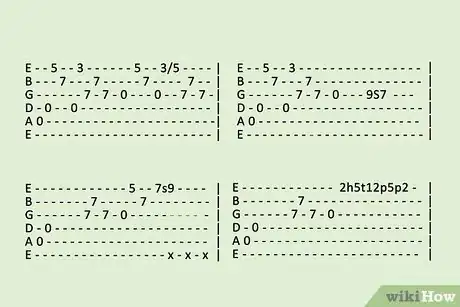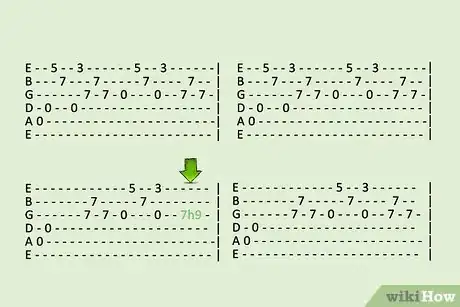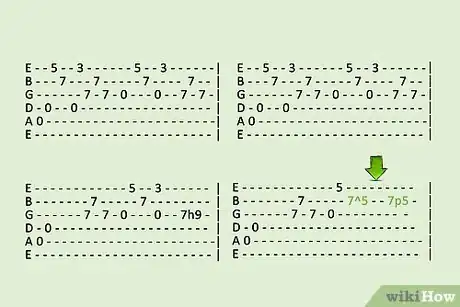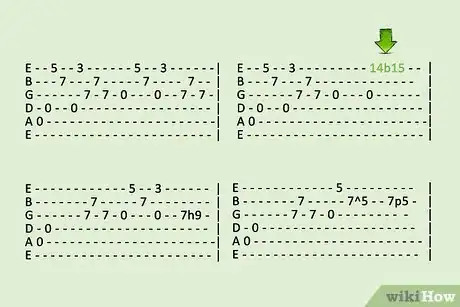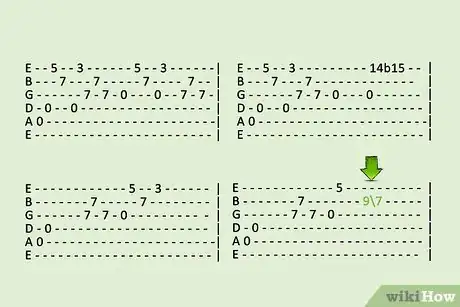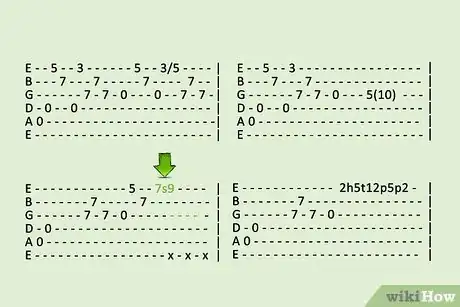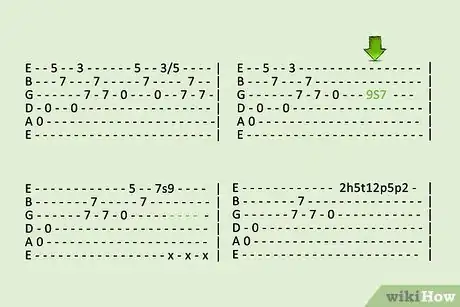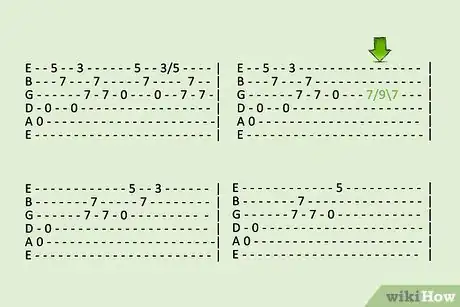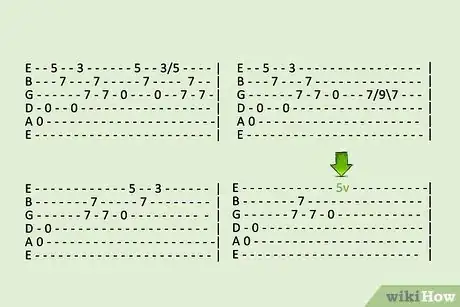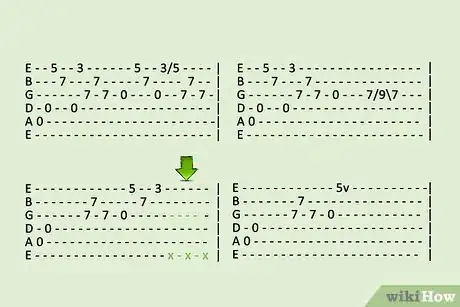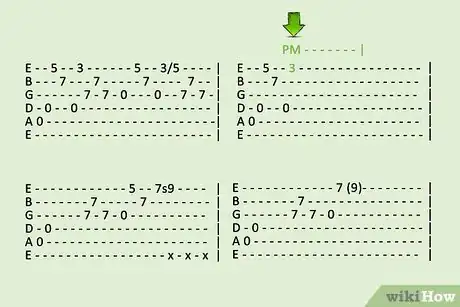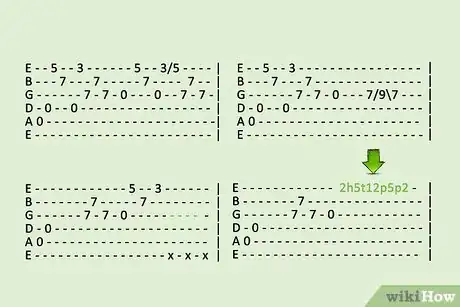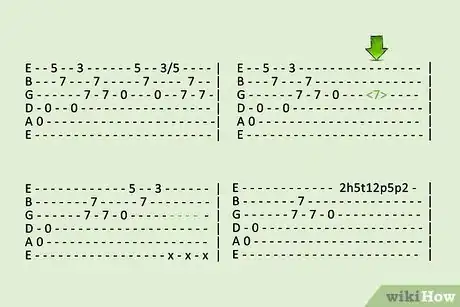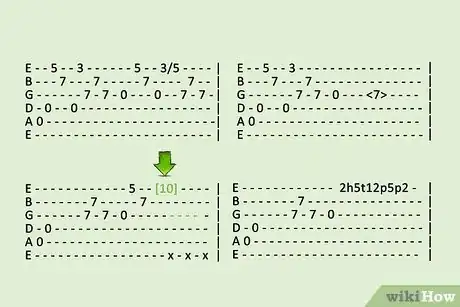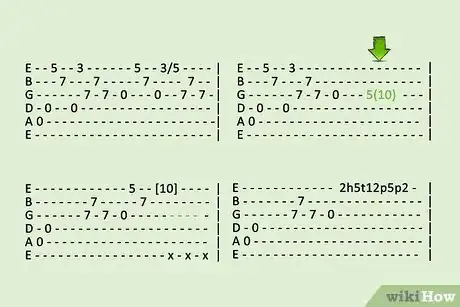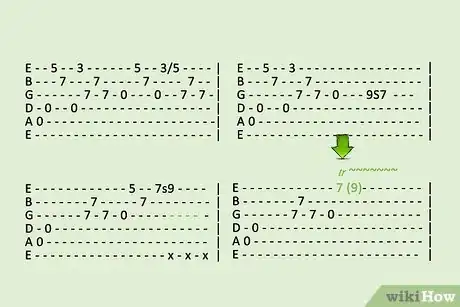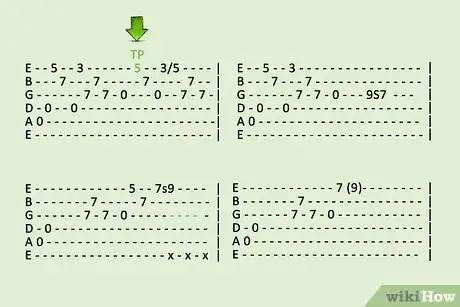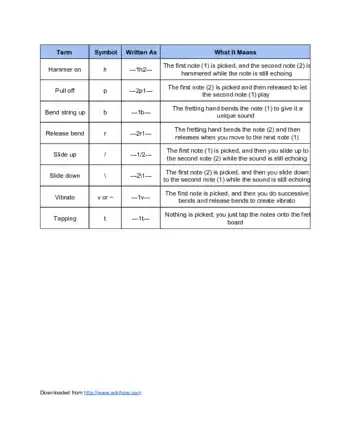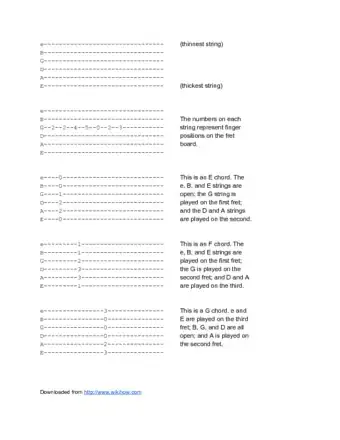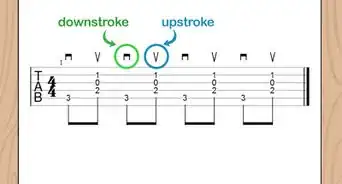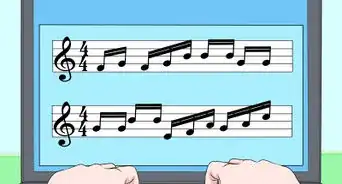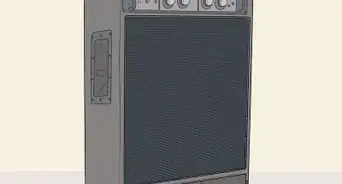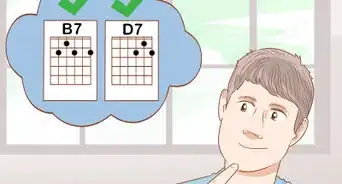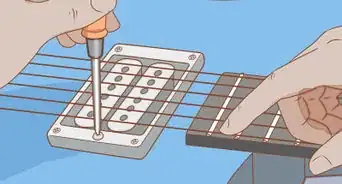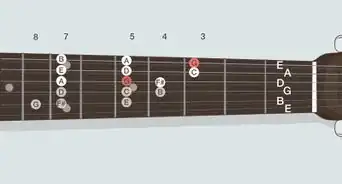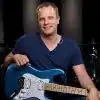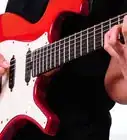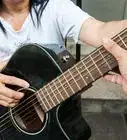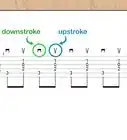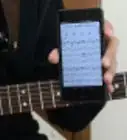This article was co-authored by Nate Savage. Nate Savage is a professional guitarist with over 16 years of experience teaching guitar to students around the world. His YouTube channel, Guitareo, has over 450,000 subscribers.
wikiHow marks an article as reader-approved once it receives enough positive feedback. This article received 16 testimonials and 88% of readers who voted found it helpful, earning it our reader-approved status.
This article has been viewed 2,364,687 times.
Guitarists have their own special system of music notation called guitar tablature, or "guitar tabs" for short. Using guitar tabs, a guitarist can play a wide variety of music without ever having to learn how to read standard sheet music. Though guitar tabs aren't a perfect way of describing music, they've allowed newer generations of guitarists to quickly and easily share information about how to play songs across the globe via the internet. Every guitarist should have at least a basic understanding of how to read tablature - it's the de facto shorthand for much of the guitar music you'll find written out online.[1]
Steps
Using Tabs to Fret Notes and Chords
-
1View tab notation as a representation of the guitar's strings. A tab is usually written using six horizontal lines, each corresponding with a string on the guitar. The bottom line represents the lowest, thickest string, while the top string represents the highest, thinnest string. For standard tunings, this means that the lines will represent, from the bottom up, the low E, A, D, G, B and high E strings.
- E----------------------------||(Thinnest string)
- B----------------------------||
- G----------------------------||
- D----------------------------||
- A----------------------------||
- E----------------------------||(Thickest string)
-
2Use the numbers on the tab to fret spaces on the neck. Unlike normal musical notation, guitar tabs don't tell you which notes to play. Instead, they tell you where to put your fingers. Numbers on the lines correspond to frets on the fretboard. Each number represents a specific fret on the line it's written on. For instance, a "1" on the bottom line means to fret the first fret of the lowest string and play that note.[2]
- If the number is greater than 0, (1, 2, 3, 4, etc), then press your finger on that fret when you play, with "1" being the fret closest to the stock and fret numbers increasing as you move towards the guitar's body. If the number is 0, then pluck the open string without fretting any notes.
Advertisement -
3Play vertically stacked numbers at the same time. When reading tabs, many times, you'll come across numbers that are aligned vertically. These are chords. Fret every note in the chord as written, then play the notes all at the same time. You'll get a fuller sound then. You might see the chord name written as well. See Example 2 below.
-
4Proceed from left to right. Tabs are read like sentences in a book - read them from left to right, across the page, dropping down to the next line only when you've reached the end of the previous. Play the notes and chords in sequence as you read them from left to right.
- Note that most (but not all) tabs don't display the rhythm with which you should play the notes in the tab. They may break the tab into measures (usually signified by vertical lines in the tab between measures, but they won't tell you the rhythm of the notes within the measures. In this case, it's best to listen to the song while you read the tab to[3] find the beat.
- Some advanced tabs do count out the beat for you - this is usually done by including rhythmic markings along the top of the tab notation. Each marking is vertically aligned with a note or a rest to give a sense of how long the note or rest lasts. Typical rhythmic markings include:
- w = whole note h = half note q = quarter note. e = eighth note. s = sixteenth note. Sometimes & markings are included to show that a note or rest lies on the "and" of a certain beat.
- A dot after the rhythm marking means the corresponding note or rest is dotted. For instance, q. = dotted quarter note.
- For rhythm basics, see How to Read Music
-
5Look for lyrics or chord changes. Many songs have guitar parts made up solely (or mostly) of chords. This is especially true for rhythm guitar parts. In this case, the tab may forgo typical tab notation in favor of a simplified list of chord changes. These chords are almost always written in standard chord notation (Amin = A minor, E7 = E dominant 7, etc.) Simply play the chords in the order that they're listed - if it's not noted otherwise, try playing one chord per measure, but if the changes don't sound right, listen to the song for the strumming pattern.
- Sometimes, these chord changes are printed above the lyrics of the song to give you a sense of when these chords are played, as in this snippet from a tab for The Beatles' "Twist and Shout:"
- (A7)...................(D)...............(G)............(A)
- Well shake it up baby, now (shake it up baby)
Reading Special Symbols
-
1Look for additional symbols in the tab. As you can see in the example above, many tabs aren't just collections of lines and notes. Tabs use a wide variety of special symbols to tell you how to play the notes in the tab. Most symbols refer to specific playing techniques - to make a song sound as much like the recording as possible, pay attention to these special markings.[4]
-
2Learn the symbol for Hammer ons. In a tab, an "h" inserted between two notes (e.g. 7h9) means to perform a hammer on. To hammer on, play the first note normally, then use a finger on your fretting hand to tap down on the second note without using your strumming hand to pluck the note.
- Sometimes "^" is used instead (e.g. 7^9).
-
3Learn the symbol for Pull offs. - A "p" inserted between two notes (e.g. 9p7) means to perform a pull off, which is essentially the opposite of a hammer on. Pluck the first note while using another finger to fret the second note. Then, quickly lift the finger fretting the first note. The second note will sound.
- As with hammer ons, sometimes "^" is used instead (e.g. 9^7). In this case, know to perform a pull off if the second note is lower and a hammer on if the second note is higher.
-
4Learn the symbol for string bends. If a "b" is inserted between two fret numbers (e.g. 7b9), fret the first note and bend it up until it sounds like the second.
- Sometimes the second number is in parentheses, and occasionally the "b" is omitted altogether. If there is an "r" it denotes what the note should be released to (e.g. 7b9r7).
-
5Learn the symbols for slide techniques. Perform a basic slide by striking a note, moving your finger up or down a string without releasing it from the fretboard, then striking another note. An ascending slide is marked by a forward slash "/" and a descending slide is marked by a backwards slash "\" (e.g. 7/9\7).
- A lowercase "s" usually means to perform a legato slide. This is like a normal slide, but you only strike the first note with your pick. Let your target note sound simply from the motion in your fret hand.
- There is debate among guitarists over whether a light pick strike is appropriate for the target note. The most important thing is to remember to leave no gap between notes.
- Shift slides are signified by an uppercase "S." In this case, strike the target note without striking the initial note of the slide.
- A lowercase "s" usually means to perform a legato slide. This is like a normal slide, but you only strike the first note with your pick. Let your target note sound simply from the motion in your fret hand.
-
6Learn the symbols for tremolo bar techniques. If your guitar has a tremolo bar, (also known as a "whammy bar" or "vibrato bar") follow these symbols to achieve some remarkably out-there effects.
- If you see a "\n/," where n = some number, perform a tremolo bar dip. Quickly hit and release the bar to dip the note's pitch. The number between the slashes gives an indication of the pitch you should dip to - dip the pitch by "n" semitones (a semitone is the same as the pitch between two adjacent frets.) For instance, "\5/" means to drop the pitch by 5 semitones, which will be the same tone as 5 frets below the original note.
- If you see a "\n," where n = some number, fret note "n," then strike it and depress the tremolo bar deeply to dramatically drop the pitch.
- If you see "n/," raise the tremolo bar up after striking note "n" to raise the pitch. On some guitars, you can also put your bar in "inverted" position first so that hitting the bar raises the pitch rather than lowers it.
- If you see "/n\," perform a tremolo bar inverted dip by first depressing the tremolo bar, then raising it. As above, this also works in inverted position.
-
7Learn the symbol for vibrato. Look for "~" or "v". If you see these symbols, perform vibrato on the preceding note. Strike the note, then use your fretting hand to rapidly bend and unbend the string, vibrating the pitch of the note.
-
8Learn the symbols for muting techniques. Several tab symbols indicate different methods for giving notes a "muted" sound.
- If you see an "x" or a dot below the number, mute the string. Lay your fretting hand finger(s) across the designated strings so that when you strike them they produce a dull, clicking sound. Several "x" in a row, on adjacent strings, indicates a rake - just mute more than one string at once.
- If you see "PM," play using palm muting. For standard right-handed guitar playing, gently lay the edge of your right palm across the strings near the guitar's bridge. When you strike the notes (with the same hand as is providing the mute), you should hear the tone of the note, but with a subdued, dead quality. Move your hand slightly up the strings toward the neck to deaden the notes more.
-
9Learn the symbol for tapping. Tapping is usually represented by a "t." If you see a "t" in a string of notes, (e.g. 2h5t12p5p2) use one of the fingers on your picking hand (usually your right hand) to tap down hard on the indicated fret. This is a useful technique for making very rapid, fast changes in pitch.
-
10Learn the symbols for harmonic techniques. Guitar tabs differentiate between several different techniques for playing harmonics - bell-like tones created by special fretting techniques.
- For natural harmonics, the fret is surrounded by "< >" (e.g. <7>). If you see this, lay a fretting finger across the metal line at the right of the fret, not the middle of the fret. Then, strike the string for a clear bell tone.
-
Pinch harmonics are signified by surrounding the fret number in brackets (e.g. [n]). To perform a pinch harmonic, strike the note with your pick hand while your pick hand thumb is also touching the note. Use vibrato from your fret hand to add sustain to the tone.[5]
Pinch harmonics are difficult. It requires lots of practice.
- Note: these are best performed on an electric guitar with distortion using a bridge pickup.
- Tapped harmonics are signified by two notes, the second enclosed in parentheses (e.g. n(n)). Tapped harmonics are like natural harmonics, but shifted around the neck. Fret the first note, then use a finger on your pick hand to slap or strike the string at the second fret position.
-
11Learn the symbol for trills. When you see a "tr" written in or above the tab, it's usually between (or above) two notes. Often, it's accompanied by a string of tildes ("~'s.") This simply means to strike the first note, then rapidly hammer on to the second note and pull off to the first note again and again.
-
12Learn the symbol for tremolo picking. "TP" means you should tremolo pick the note - essentially, pick the single note over and over as rapidly as you can. Sometimes, a TP symbol is followed by a string of tildes or dashes to give you a sense of how long to tremolo pick.
Reading an Example Tab
-
1Glance over the tab below. Notice that it shows several three-note chords as well as some individual notes descending on the higher strings. In the following steps, we'll walk through this tab beat-by-beat.
- E---------------3-0--------------------||
- B-------------------3-0----------------||
- G---7-7-7---------------2-0------------||
- D-2-7-7-7-7-7-7------------------------||
- A-2-5-5-5-7-7-7------------------------||
-
E-0-------5-5-5------------------------||
-
2Start with the chord at the far left. In this case, first you would play a power chord in E (Middle finger/Finger 2 on the second fret on the A string, ring finger/Finger 3 on the second fret on the D string, and no finger on the low E string) strumming those first 3 strings (E,A,D) once. Play the chord highlighted with parentheses below:
- E-------------3-0-----------------||
- B----------------3-0--------------||
- G-----777-----------2-0-----------||
- D-(2)-777--777--------------------||
- A-(2)-555--777--------------------||
- E-(0)------555--------------------||
-
3Proceed to the next two chords. The next chord you would play would be a power chord on the fifth fret of A three times. So you would play with your index finger on the fifth fret of A, your middle finger on the seventh fret of D, and your ring finger on the seventh fret of G. Then, simply shift this finger shape down one string so that your index finger is on the fifth fret of the E string with your other fingers on the seventh frets of the A and D strings. Play the chords in the sequence that they're highlighted with parentheses below:
- E-------------3-0-----------------||
- B----------------3-0--------------||
- G----(7)77-----------2-0----------||
- D-2--(7)77--777-------------------||
- A-2--(5)55--777-------------------||
-
E-0---------555-------------------||
- E---------------3-0---------------||
- B------------------3-0------------||
- G----7(7)7------------2-0---------||
- D-2--7(7)7--777-------------------||
- A-2--5(5)5--777-------------------||
-
E-0---------555-------------------||
- E---------------3-0---------------||
- B------------------3-0------------||
- G----77(7)------------2-0---------||
- D-2--77(7)--777-------------------||
- A-2--55(5)--777-------------------||
-
E-0---------555-------------------||
- E---------------3-0---------------||
- B------------------3-0------------||
- G----777--------------2-0---------||
- D-2--777--(7)77-------------------||
- A-2--555--(7)77-------------------||
-
E-0-------(5)55-------------------||
- E---------------3-0---------------||
- B------------------3-0------------||
- G----777--------------2-0---------||
- D-2--777--7(7)7-------------------||
- A-2--555--7(7)7-------------------||
-
E-0-------5(5)5-------------------||
- E---------------3-0---------------||
- B------------------3-0------------||
- G----777--------------2-0---------||
- D-2--777--77(7)-------------------||
- A-2--555--77(7)-------------------||
-
E-0-------55(5)-------------------||
-
4Play the individual notes at the right. After the first 3 chords in the example, proceed to the right and play the single notes. Put any finger on the third fret of the high E string, pluck once, then play the open high E string, and so on through the six descending notes. Play the notes below in the order they're highlighted in parentheses:
- E---------------(3)-0-------------------||
- B--------------------3-0----------------||
- G---7-7-7----------------2-0------------||
- D-2-7-7-7-7-7-7-------------------------||
- A-2-5-5-5-7-7-7-------------------------||
-
E-0-------5-5-5-------------------------||
- E---------------3-(0)-------------------||
- B--------------------3-0----------------||
- G---7-7-7----------------2-0------------||
- D-2-7-7-7-7-7-7-------------------------||
- A-2-5-5-5-7-7-7-------------------------||
-
E-0-------5-5-5-------------------------||
- E---------------3-0---------------------||
- B--------------------(3)-0--------------||
- G---7-7-7------------------2-0----------||
- D-2-7-7-7-7-7-7-------------------------||
- A-2-5-5-5-7-7-7-------------------------||
-
E-0-------5-5-5-------------------------||
- E---------------3-0---------------------||
- B--------------------3-(0)--------------||
- G---7-7-7------------------2-0----------||
- D-2-7-7-7-7-7-7-------------------------||
- A-2-5-5-5-7-7-7-------------------------||
-
E-0-------5-5-5-------------------------||
- E---------------3-0---------------------||
- B--------------------3-0----------------||
- G---7-7-7----------------(2)-0----------||
- D-2-7-7-7-7-7-7-------------------------||
- A-2-5-5-5-7-7-7-------------------------||
-
E-0-------5-5-5-------------------------||
- E---------------3-0---------------------||
- B--------------------3-0----------------||
- G---7-7-7----------------2-(0)----------||
- D-2-7-7-7-7-7-7-------------------------||
- A-2-5-5-5-7-7-7-------------------------||
-
E-0-------5-5-5-------------------------||
-
5Put it all together. Play the chords and notes from left to right without stopping. Tap your foot, playing each note or chord on each tap of your foot. Work slowly and carefully, only increasing your speed once you've mastered playing the tab slowly.
Guitar Tab Cheat Sheets
Expert Q&A
-
QuestionHow can I play guitar tabs faster?
 Michael PapenburgMichael Papenburg is a Professional Guitarist based in the San Francisco Bay Area with over 35 years of teaching and performing experience. He specializes in rock, alternative, slide guitar, blues, funk, country, and folk. Michael has played with Bay Area local artists including Matadore, The Jerry Hannan Band, Matt Nathanson, Brittany Shane, and Orange. Michael currently plays lead guitar for Petty Theft, a tribute to Tom Petty and the Heartbreakers.
Michael PapenburgMichael Papenburg is a Professional Guitarist based in the San Francisco Bay Area with over 35 years of teaching and performing experience. He specializes in rock, alternative, slide guitar, blues, funk, country, and folk. Michael has played with Bay Area local artists including Matadore, The Jerry Hannan Band, Matt Nathanson, Brittany Shane, and Orange. Michael currently plays lead guitar for Petty Theft, a tribute to Tom Petty and the Heartbreakers.
Professional Guitarist Play along with a metronome! Start at a slow speed that's easy to play along with and then gradually increase the speed as you get more comfortable with the music.
Play along with a metronome! Start at a slow speed that's easy to play along with and then gradually increase the speed as you get more comfortable with the music. -
QuestionWhat is meant by the line between numbers -4-7-5-8?
 Community AnswerThe line represents the string and is just to help you to realize the frets you play are all on the same string.
Community AnswerThe line represents the string and is just to help you to realize the frets you play are all on the same string. -
QuestionHow do I read guitar tabs when it is notes?
 Community AnswerTabs and notes are different systems of telling the performer what to play. You need to understand which fret on which string produces which note in order to read the notation that isn't in tabs.
Community AnswerTabs and notes are different systems of telling the performer what to play. You need to understand which fret on which string produces which note in order to read the notation that isn't in tabs.
Warnings
- Some tabs on the internet are user submitted and aren't always accurate.⧼thumbs_response⧽
- Many tab sites on the internet use artists' works without permission. Using a legal tab site (such as MxTabs.net or GuitarWorld.com) ensures that the tabs you are using are hosted with the artists' permission. The artists often work out deals with the sites to get part of the ad revenue.⧼thumbs_response⧽
- Some musicians don't want their works published without permission, so be careful with what you write and post on the internet.⧼thumbs_response⧽
- In addition to providing no rhythmic information, tabs are also limited compared to standard music notation in that they don't communicate musical information such as chord voicing, separating melody from accompaniment, showing melodic contour, or any other intricate musical detail.⧼thumbs_response⧽
- One of the major shortcomings of guitar tabs is that they don't tell you exactly when to play the notes. If you're having a hard time playing the music to a good rhythm, try another piece or consider learning to read standard music notation.⧼thumbs_response⧽
- Guitar tab will not aid you in the process of learning and understanding music theory, as it only tells you where to position your fingers. In many printed books you may see guitar tab alongside standard notation. While useful for guitarists of any experience level, guitar tab is perfect for the casual player.[6]⧼thumbs_response⧽
Things You'll Need
- Guitar
- Pick (optional)
References
- ↑ https://www.musicnotes.com/now/tips/how-to-read-guitar-tabs/
- ↑ https://www.guitarlessons.com/guitar-lessons/guitar-theory-ear-training-and-reading/how-to-read-guitar-tabs
- ↑ https://www.songsterr.com/a/wa/howToReadTab
- ↑ https://www.guitartricks.com/helptab
- ↑ http://www.ultimate-guitar.com/lessons/guitar_techniques/make_your_guitar_scream_natural_and_artificial_harmonics.html
- ↑ https://www.musicnotes.com/now/tips/how-to-read-guitar-tabs/
- Videos from GuitarLessons.com
About This Article
To read guitar tabs, start by corresponding each of the 6 tabs with a string on the guitar, with the low E representing the thinnest string and the high E representing the thickest string. Next, use the numbers on the tab to determine where you should place your fingers. For example, a "1" on the bottom line means to play the lowest note on the first fret. Then, read the notes on the tab from left to right in sequence, and drop down to the next line only when you've reached the end of the line before it. For more advice from our Music reviewer, including how to read special symbols, like those for string bends or slide techniques, read on!
